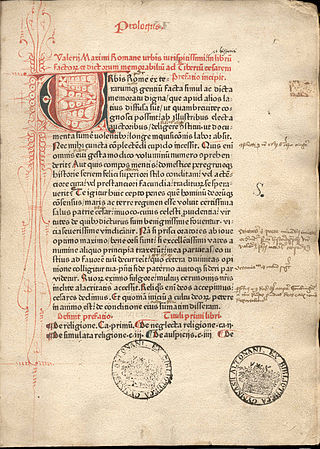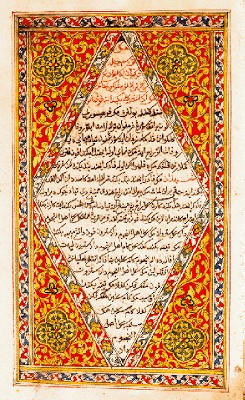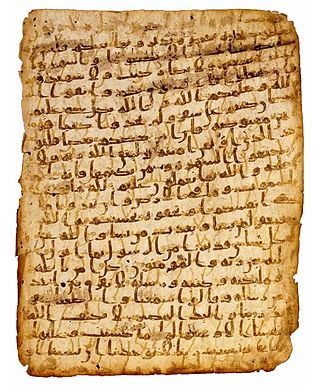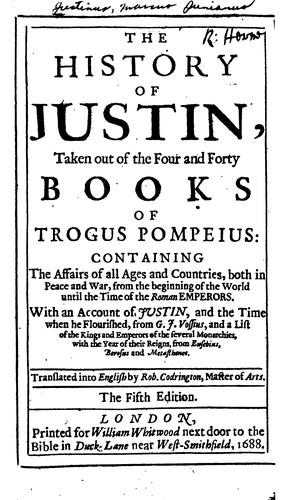Related Research Articles

The Glagolitic script is the oldest known Slavic alphabet. It is generally agreed to have been created in the 9th century by Saint Cyril, a monk from Thessalonica. He and his brother Saint Methodius were sent by the Byzantine Emperor Michael III in 863 to Great Moravia to spread Christianity among the West Slavs in the area. The brothers decided to translate liturgical books into the contemporary Slavic language understandable to the general population. As the words of that language could not be easily written by using either the Greek or Latin alphabets, Cyril decided to invent a new script, Glagolitic, which he based on the local dialect of the Slavic tribes from the Byzantine theme of Thessalonica.

Gospel originally meant the Christian message, but in the 2nd century it came to be used also for the books in which the message was reported. In this sense a gospel can be defined as a loose-knit, episodic narrative of the words and deeds of Jesus, culminating in his trial and death and concluding with various reports of his post-resurrection appearances. Modern biblical scholars are cautious of relying on the gospels uncritically, but nevertheless, they provide a good idea of the public career of Jesus, and critical study can attempt to distinguish the original ideas of Jesus from those of the later Christian authors.

Gregorian chant is the central tradition of Western plainchant, a form of monophonic, unaccompanied sacred song in Latin of the Roman Catholic Church. Gregorian chant developed mainly in western and central Europe during the 9th and 10th centuries, with later additions and redactions. Although popular legend credits Pope Gregory I with inventing Gregorian chant, scholars believe that it arose from a later Carolingian synthesis of the Old Roman chant and Gallican chant.

Lucius Cassius Dio, also known as Dio Cassius, was a Roman historian and senator of maternal Greek origin. He published 80 volumes of the history on ancient Rome, beginning with the arrival of Aeneas in Italy. The volumes documented the subsequent founding of Rome, the formation of the Republic, and the creation of the Empire, up until 229 AD. Written in Ancient Greek over 22 years, Dio's work covers approximately 1,000 years of history. Many of his 80 books have survived intact, or as fragments, providing modern scholars with a detailed perspective on Roman history.

Valerius Maximus was a 1st-century Latin writer and author of a collection of historical anecdotes: Factorum ac dictorum memorabilium libri IX. He worked during the reign of Tiberius.

The Deipnosophistae is an early 3rd-century AD Greek work by the Greek author Athenaeus of Naucratis. It is a long work of literary, historical, and antiquarian references set in Rome at a series of banquets held by the protagonist Publius Livius Larensis for an assembly of grammarians, lexicographers, jurists, musicians, and hangers-on.
Yeshu is the name of an individual or individuals mentioned in rabbinic literature, Jesus when used in the Talmud. The name Yeshu is also used in other sources before and after the completion of the Babylonian Talmud. It is also the modern Israeli spelling of Jesus.

Quintus Curtius Rufus was a Roman historian, probably of the 1st century, author of his only known and only surviving work, Historiae Alexandri Magni, "Histories of Alexander the Great", or more fully Historiarum Alexandri Magni Macedonis Libri Qui Supersunt, "All the Books That Survive of the Histories of Alexander the Great of Macedon." Much of it is missing. Apart from his name on the manuscripts, nothing else certain is known of him. This fact alone has led philologists to believe that he had another historical identity, to which, due to the accidents of time, the link has been broken. A few theories exist. They are treated with varying degrees of credibility by various authors. Meanwhile, the identity of Quintus Curtius Rufus, historian, is maintained separately.

The Malay Annals, originally titled Sulalatus Salatin, is a literary work that gives a romanticised history of the origin, evolution and demise of the great Malay maritime empire, the Malacca Sultanate. The work, which was composed sometime between the 15th and 16th centuries, is considered one of the finest literary and historical works in the Malay language.

The work called Ab urbe condita, sometimes referred to as Ab urbe condita libri, is a monumental history of ancient Rome, written in Latin between 27 and 9 BC by Livy, a Roman historian. The work covers the period from the legends concerning the arrival of Aeneas and the refugees from the fall of Troy, to the city's founding in 753 BC, the expulsion of the Kings in 509 BC, and down to Livy's own time, during the reign of the emperor Augustus. The last event covered by Livy is the death of Drusus in 9 BC. 35 of 142 books, about a quarter of the work, are still extant. The surviving books deal with the events down to 293 BC, and from 219 to 166 BC.

The Alexander Romance is an account of the life and exploits of Alexander the Great. Although constructed around a historical core, the romance is mostly fictional. It was widely copied and translated, accruing various legends and fantastical elements at different stages. The original version was composed in Ancient Greek some time before 338 CE, when a Latin translation was made, although the exact date is unknown. Several late manuscripts attribute the work to Alexander's court historian Callisthenes, but Callisthenes died before Alexander and therefore could not have written a full account of his life. The unknown author is still sometimes known as Pseudo-Callisthenes.

Atropates was a Persian nobleman who served Darius III, then Alexander the Great, and eventually founded an independent kingdom and dynasty that was named after him. Diodorus (18.4) refers to him as Atrápēs (Ἀτράπης), while Quintus Curtius (8.3.17) erroneously names him 'Arsaces'.
The Apostolic Tradition is an early Christian treatise which belongs to the genre of the ancient Church Orders. It has been described to be of "incomparable importance as a source of information about church life and liturgy in the third century".

The Anglo-Saxon Chronicle is a collection of annals in Old English, chronicling the history of the Anglo-Saxons. The original manuscript of the Chronicle was created late in the 9th century, probably in Wessex, during the reign of Alfred the Great. Multiple copies were made of that one original and then distributed to monasteries across England, where they were independently updated. In one case, the Chronicle was still being actively updated in 1154.
The historical reliability of the Gospels is the reliability and historic character of the four New Testament gospels as historical documents. While all four canonical gospels contain some sayings and events which may meet one or more of the five criteria for historical reliability used in biblical studies, the assessment and evaluation of these elements is a matter of ongoing debate. Virtually all scholars of antiquity agree that a human Jesus existed, but scholars differ on the historicity of specific episodes described in the biblical accounts of Jesus, and the only two events subject to "almost universal assent" are that Jesus was baptized by John the Baptist and was crucified by the order of the Roman Prefect Pontius Pilate. Elements whose historical authenticity is disputed include the two accounts of the Nativity of Jesus, the miraculous events including the resurrection, and certain details about the crucifixion.

In Muslim tradition the Quran is the final revelation from God, Islam's divine text, delivered to the Islamic prophet Muhammad through the angel Jibril (Gabriel). Muhammad's revelations were said to have been recorded orally and in writing, through Muhammad and his followers up until his death in 632 CE. These revelations were then compiled by first caliph Abu Bakr and codified during the reign of the third caliph Uthman so that the standard codex edition of the Quran or Muṣḥaf was completed around 650 CE, according to Muslim scholars. This has been critiqued by some western scholarship, suggesting the Quran was canonized at a later date, based on the dating of classical Islamic narratives, i.e. hadiths, which were written 150–200 years after the death of Muhammad, and partly because of the textual variations present in the Sana'a manuscript. With the discovery of earlier manuscripts which conform to the Uthmanic standard however, the revisionist view has fallen out of favor and been described as "untenable", with western scholarship generally supporting the classical Muslim view.

The Histories of Alexander the Great is the only surviving extant Latin biography of Alexander the Great. It was written by the Roman historian Quintus Curtius Rufus in the 1st-century AD, but the earliest surviving manuscript comes from the 9th century.
Three main sets of works are attributed to Florus : Virgilius orator an poeta, an Epitome of Roman History and a collection of 14 short poems. As to whether these were composed by the same person, or set of people, is unclear, but the works are variously attributed to:

The Historia Philippicae et Totius Mundi Origines et Terrae Situs, or Philippic History and Origins of the Entire World and All of its Lands, by the second-century Roman writer Justin is an epitome of the Augustan historian Pompeius Trogus' earlier expansive work the Historiæ Phillippicæ, which has not survived and the only surviving link, although much of the content has been altered.

Codex Mutinensis graecus 122 is a 15th-century codex written in Greek, today stored in the Biblioteca Estense in Modena, Italy. The designation Mutinensis gr. 122 is modern and the codex itself bears the title Epitome of Histories as the bulk of its content is made up of a copy of large parts of the 12th-century Byzantine historian Joannes Zonaras's Epitome of Histories.
References
- ↑ Baynham, Elizabeth and Yardley, J. (1997) The Historiography of Alexander the Great: The Metz Epitome. University of Newcastle 2000.
- ↑ Baynham, E.(1995) An Introduction to the Metz Epitome: its Traditions and Value, Antichthon 29, 1995,
- 1 2 3 Loube, Heather The (1995) "Metz Epitome": Alexander (July, 330 B.C.-July, 325 B.C.) A commentary. University Ottawa ON Canada .
- 1 2 Worthington, Ian (2003) Alexander the Great: a reader. page 10